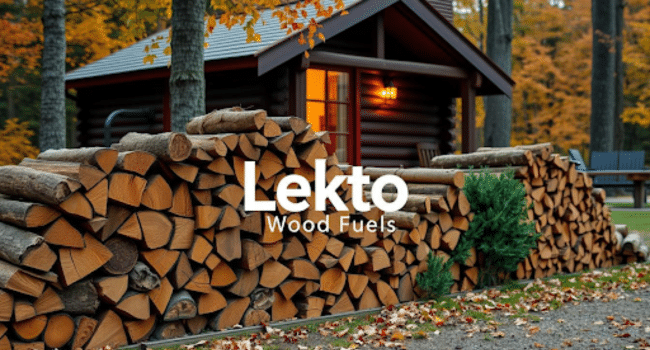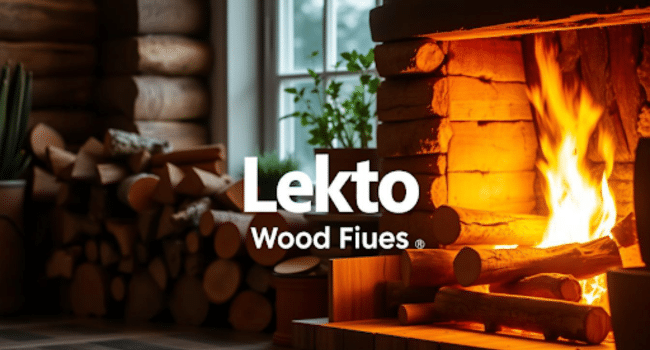Table of Contents
As snowy weather conditions gets nearer, individuals are searching out strategies to hold their homes warm. Firewood is a famous choice for heating. Choosing the proper logs is key to staying heat and relaxed.
We’ll help you recognize special kinds of firewood and what sort you need. This manual is for anyone, whether you’re experienced with fireplaces or new to heating your home. You’ll learn how to pick the best logs for your needs.
Understanding the Different Types of Firewood
Picking the proper kindling can considerably influence your property’s glow. Kindling falls into two crucial classes: hardwood and softwood. Knowing their differences enables you to select the high-quality fuel for your heating desires.
Hardwood logs, like o.K.And maple, are denser and burn longer. This method delivers more warmness and, ultimately, longer. They additionally produce less smoke and sparks, making them more secure for indoor use.

On the other hand, softwood logs, including pine, burn faster. They won’t warm as much as hardwood but are extraordinary for quick fires. Softwood is often less expensive and easier to find in a few regions.
Choosing between hardwood and softwood depends upon your heating gadget and possibilities. Understanding their variations facilitates keeping your home warm and relaxed all winter.
The Advantages of Burning Hardwood Logs
Hardwood logs for heating Are a top preference for domestic heating. They are regarded for their high fine and performance. Oak, maple, and ash are examples of hardwoods that burn nicely.
These logs burn longer and hotter than softwoods, providing greater warmth for your home. They additionally burn cleaner, leaving much less ash and soot behind.
Hardwood logs give off warmth gradually, keeping your home warm. This makes them top-notch for heating your space calmly. Plus, they’re better for the surroundings because they burn longer and produce less waste.
Popular Hardwood Options for Heating
Hardwood species are tremendous for heating your property. They burn longer and hotter than softwoods. Plus, they may be easier to break up. Let’s study a few pinnacle hardwood options for your house.
Oak is a favourite for firewood. It burns hot and long. Maple offers a consistent flame and masses of heat. Birch is simple to split and starts to evolve quickly.
Ash is any other incredible desire. It burns hot and long and is simple to break up.
Choosing the proper hardwood depends on warmth output, burn time, and splitting ease. Knowing the trends of various hardwoods helps you pick the fine for your property.
Softwood Logs: Pros and Cons
Hardwoods are regularly the top choice for heating homes, but softwoods like pine and fir are also desirable. Each has its own set of advantages and disadvantages to consider when picking gas for your fireside or wood range.
Softwood logs light up quickly, which is a huge plus. They begin burning swiftly, making it smooth to get a fireplace going. This is top-notch for folks who need to warm up quickly. But they do not burn as long or as hot as hardwoods.
Using softwood logs additionally means you may have to smooth your chimney more regularly. This is because they produce more creosote, a flammable substance. Keeping your chimney smooth is essential to avoid fires.
Choosing between softwood and hardwood logs depends on what you need. Softwoods are easy to light, but hardwoods burn longer and are warmer. Knowing the pros and cons of each helps you select the quality for your property’s warmth.
Logs for Heating: Choosing the Right Size
Size is critical when it comes to firewood. The length of your logs impacts how properly your heating machine works. Whether you have a hearth, timber stove, or furnace, picking the right firewood size is vital. It enables get the maximum heat and burns cleanly and effectively.
The satisfactory size for firewood is commonly between sixteen to 24 inches long and six to eight inches wide. This firewood duration and diameter are best for maximum domestic heating. They balance warmth output and make handling logs easy. Logs that are too small burn too fast, and large ones are tough to manage and won’t match.
The best firewood length can totally depend on your heating equipment. Wood stoves need shorter, thinner logs for suitable air flow and burning, while fireplaces can handle larger, longer logs. Always check your appliance’s manual or ask a nearby firewood dealer for the best log dimensions for heating.
Seasoning Your Firewood
Seasoning your firewood properly is key for the best warmth and less creosote. The drying method lowers timber moisture to an appropriate stage, making your logs burn properly and easily.
The pleasant moisture for seasoned firewood is 15-20%. Higher moisture can cause too much smoke and creosote. To get the proper humidity, cut up and stack your timber in a dry, well-ventilated location for 6-one years.
There are some ways to dry wood, like air drying, kiln drying, or using a dehumidifier. Air drying is the cheapest but takes time. Kiln drying or a dehumidifier can dry wood quicker but cost more in advance.
Storing pro firewood efficaciously is likewise crucial. Stack logs off the ground and cover the top, but leave aspects open. This maintains moisture properly and stops mould or fungus. With exact seasoning and storage, your firewood will burn efficaciously and cleanly.
Storing Logs for Heating Properly
Keeping your firewood in excellent form is essential. Whether you narrow it yourself or purchase it, protecting it from the weather is prime. A correct firewood shed or garage location is vital for preserving logs dry and ready to burn.
When storing firewood, stack it in a raised, well-ventilated spot. This keeps it away from rain and moisture. A firewood shed or included location facilitates a lot. Stacking logs in a crisscross pattern additionally helps with drying.
It’s crucial to keep your firewood dry. Use a platform or pallets to keep it off the ground. Covering the pinnacle with a tarp or water-resistant cloth helps, too, without blocking air.
Investing in excellent firewood storage solutions will pay off. They keep your logs dry and equipped for heat. Properly storing firewood makes it last longer and burn better.
Calculating Your Annual Firewood Needs
Figuring out how much firewood you need every 12 months is key to maintaining your home’s heat. You should consider your home’s size, insulation, and what kind of warmth you need. This way, you can ensure you have enough logs to keep your home comfortable all year.
Start by looking at your home’s square pictures. Bigger homes need extra firewood to stay warm. Also, older homes with terrible insulation may need more logs than newer, properly insulated ones.
Think about your heating gadget, too. Homes with timber-burning stoves or fireplaces use more firewood than those with electric or fuel furnaces. Knowing your heating needs enables you to propose the proper quantity of firewood.
After analyzing those factors, use online online equipment or communicate with local suppliers to determine your needs. This will help you purchase and shop the right amount of firewood for the following heating season.
Sourcing Quality Logs for Heating
Finding a fantastic provider for firewood is prime. Look for nearby firewood providers to get the first-class timber for your home. Many regions have firewood dealers who promote seasoned logs. These logs burn well and hold your home warm.
Online marketplaces are another alternative. They connect you with sellers or small agencies that offer excellent timber for heating. In this manner, you can support neighbourhood manufacturers and find neighbourhood firewood.
Harvesting your very own firewood is also an alternative. You can select the proper logs for your heating device. Just make sure to season and keep buying firewood nicely for iciness.
Choose a supplier that provides constant, first-class logs. This guarantees that your home stays warm and comfy throughout the icy season.
Safety Considerations When Burning Logs
Burning logs for warmth is efficient and cost-effective. But safety is paramount when using firewood, fireplaces, or wood stoves. Proper ventilation is critical to avoiding dangerous gases like carbon monoxide. Also, keeping your chimney clean is essential to preventing fires and ensuring it works properly.
Always follow the maker’s commands for your heating device for firewood safety. Use the right size and sort of logs, and season the timber to reduce creosote. Fire containment equipment, like a strong fireside grate or wooden stove door, helps keep the fire in test.
Heating safety is critical when burning logs. Check and clean your heating equipment regularly to spot and fix any problems. This way, you can revel in the warmth and look of a fireplace without the risks of firewood heating.
Logs for Heating: A Cost-Effective and Eco-Friendly Choice
Choosing the right fuel for your property’s warmth can save money and help the planet. Logs are an inexperienced and inexpensive alternative to fossil fuels. They provide many benefits for your property and the surroundings.
Logs are a renewable resource, unlike fossil fuels. They can be replenished by properly managing forests. This makes logs a low-carbon choice that helps protect our planet.
Heating with logs can also save money. Firewood costs less than electricity, gas, or propane. Thus, you may spend much less on heating, which is ideal for your pockets.
Using logs for warmth is likewise a step towards a greener way of life. It helps cut down on dangerous emissions, supporting a more sustainable world for all people.
Logs are a high-quality choice if you want to keep on heating prices or help the environment. Discover the blessings of sustainable firewood. It’s a clever, green way to warm your home.
Conclusion
Choosing the proper logs for heating your property is critical. It helps you save money and protect the surroundings. Knowing about unique forms of firewood and how to store them is essential.
Oak, maple, and birch logs are terrific for long-lasting warmth. Softwoods like pine burn speedy, however warm. It’s critical to discover the proper mix and size for satisfactory effects.
Seasoning and storing firewood properly is critical. It makes your heartburn easily and securely. With some planning, you can discover the best firewood for heating, select satisfactory logs, and experience home heating with good wood for your pockets and the planet.
